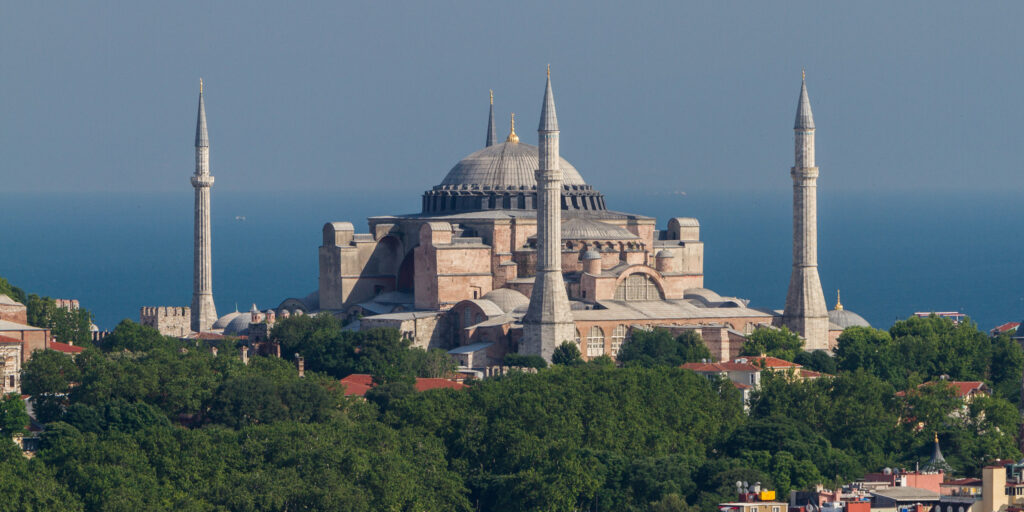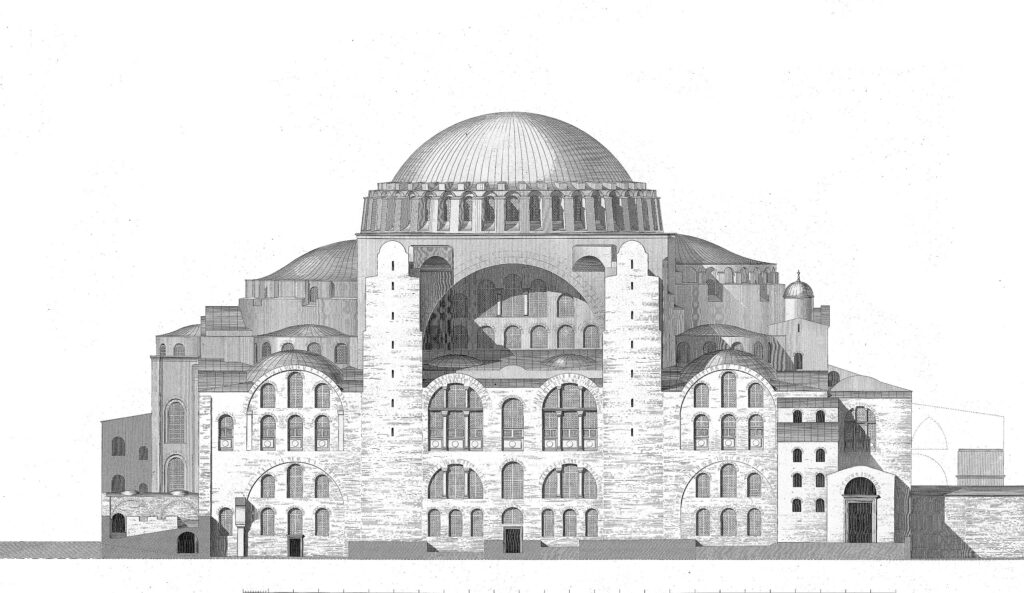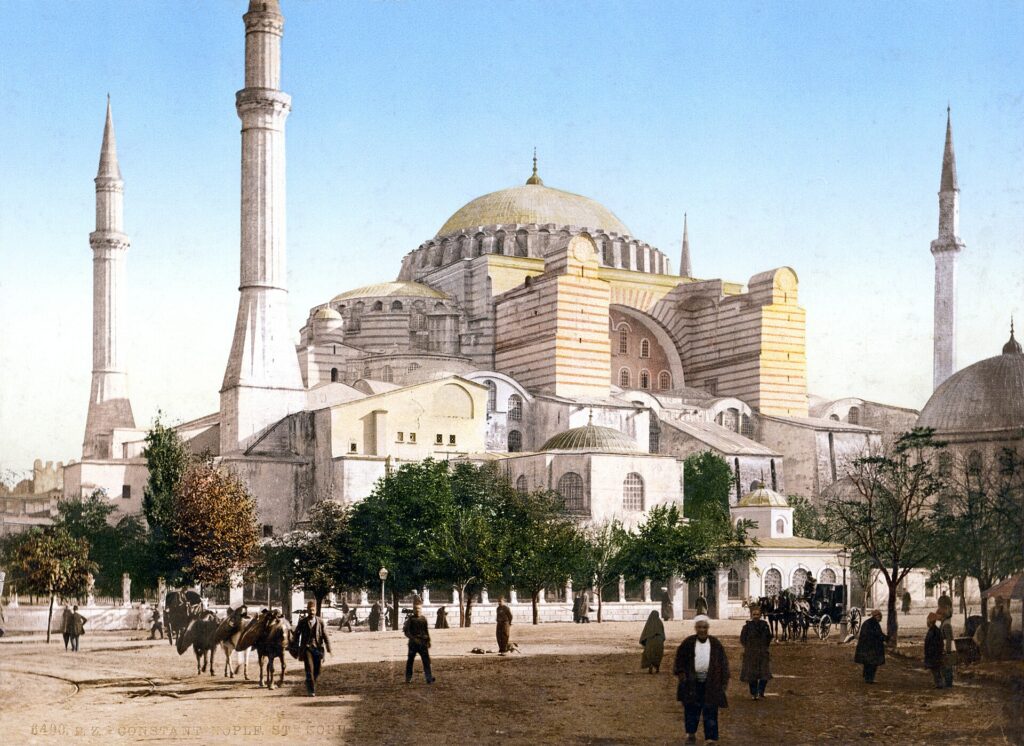In the midst of the vibrant city of Istanbul stands a structure with a history so storied and at times controversial that it’s almost unbelievable. Both an architectural marvel and a location of religious significance for multiple religions, Hagia Sophia is more than just stone and mortar. It has been a place of inspiration and worship for countless individuals.
But what exactly makes Hagia Sophia so special? It’s beautiful of course, even awe-inspiring, but its true brilliance lies in its history of metamorphosis and the many roles it has played. The true importance of Hagia Sophia lies somewhere between the faith and artistry of it, and the part it’s played in the history of Istanbul itself.
In this article, we’ll go into even deeper detail about the history of Hagia Sophia, the many roles it played in both Christianity and Islam and even its time as a museum.

History of Hagia Sophia
The history of Hagia Sophia is complicated, so we’ll break it down into smaller parts.
4th Century: The Great Church under Constantius II
The first iteration of Hagia Sophia was built in 360 CE in the legendary city of Constantinople, which is now modern-day Istanbul. It was commissioned by Emperor Constantius II and was meant to serve as a grand church for the entire city. This church was built on the foundations of a pagan temple.
The first name of Hagia Sophia was Magna Ecclesia, which translates to Great Church. It was a Christian basilica in its first form, much smaller than it would end up being by modern times, but still, one of the largest churches at the time, though there weren’t many to compare it to.
5th Century: Fire and Rebuild Under Theodosius II
Fire would be a common enemy of Hagia Sophia throughout history. The first such fire occurred in 404 CE under the rule of Theodosius II. At this point, Theodosius II had ordered a second church to be built next to the first Great Church, and both were enclosed with a single wall. The first was said to have only destroyed the 4th-century church.
The second Theodosian church was more ornate than the first, with gilded doors and elaborate carvings.
6th Century: Justinian I and the True Hagia Sophia
Another fire during the Nika Revolt of 532 destroyed the proto-Hagia Sophia church once more, and Emperor Justinian I commissioned a new church to be built on the same site.
He brought in architects Isidore of Miletus and Anthemius of Tralles to design something truly magnificent. This third iteration of the Hagia Sophia is the current structure that we see today.
Justinian I wanted his church to be larger and more awe-inspiring than anything else that had been built before. Marble was imported from all over the Mediterranean, and over 10,000 people were employed for the construction.

11th Century: The Great Schism
Before the 11th century, Hagia Sophia had existed as a Catholic Eastern Rite Church, but after the Great Schism, the split between the Eastern Orthodox and Roman Catholic churches, it became an Eastern Orthodox Church in 1054.
Over the next few centuries, it would switch back and forth between Roman Catholic and Eastern Orthodox a few times.
15 Century: Conversion into a Mosque
In 1453, Constantinople was captured by the Ottoman Empire, headed by Sultan Mehmed II. After the capture of the city, the Ottoman Empire wasted no time in using Hagia Sophia as a house of worship, turning it into a mosque.
As a mosque, Hagia Sophia had elements such as minaret towers and mihrab, a wall that indicates the direction of Mecca, added to the structure to lessen the appearance of its previous identity as a Christian establishment.
At the same time, pieces of the structure like the bells, altars, and mosaics showing Christian iconography are removed or hidden.

20th Century: Museum
After existing as a mosque for centuries, the Hagia Sophia was eventually transformed into a museum under the leadership of the first Turkish president, Mustafa Kemal Atatürk, in 1935. The carpeting that covered the original marble floor was removed, and the mosaics that had been covered for so long were revealed once more.
After briefly housing weaponry during WWII, the Hagia Sophia continued to exist as a museum but slowly deteriorated during this time. In 1996, the World Monuments Fund added the Hagia Sophia to its watch list, and in 1997 received the first grant to start restoration of the ancient structure.
21st Century: Reconversion into a Mosque
With an internationally unpopular move that had support inside the borders of Turkey, President Erdoğan announced that Hagia Sophia would be rehallowed as a mosque. Hagia Sophia was a UNESCO site, and its change back into a religious institution sparked intense debate. Those opposed to the change claimed that Hagia Sophia was a place of historical significance for people of any religious affiliation, while supporters claimed that Hagia Sophia should have never been changed into a museum in the first place.
Unlike last time, though, the Christian iconography inside Hagia Sophia will still be protected, and its status as a UNESCO heritage site will remain. When prayer is not being held at the mosque, it is still open to the public.
Why is Hagia Sophia an Architectural Marvel?
Hagia Sophia has stood the test of time, weathering wars, the shifting of empires, and centuries passing by. Starting as a simpler version of itself, Hagia Sophia was gradually turned into an architectural marvel that gives us a view into the ancient world.
Blending Byzantine and Ottoman elements in its structure and design, there are few other places as old as Hagia Sophia. Its large dome and spires can be seen from a distance, and the delicate mosaics and ancient artwork inside are equally impressive. It remains one of the best-surviving examples of the architecture of the time.
Hagia Sophia Mosaics
With the change from a museum back into a mosque, there was some fear that the mosaics of Hagia Sophia may once more be in danger. After surviving countless earthquakes, intentional destruction, plastering, and whitewashing, the mosaics have weathered centuries of trials. So what happens to them now?
With Hagia Sophia remaining a UNESCO heritage site, the mosaics are safe. During prayer at the mosque the mosaics, which are Christian in nature, are covered, but they can be viewed at other times.
The mosaics are some of the most important pieces of ancient artwork in the world. Made from glass, stone, gold leaf, and ceramics, the mosaics feature figures such as Jesus and the Virgin Mary, and other Christian iconography like six-winged angels.
For as old as they are, the mosaics are remarkably well-preserved. And now that they have been uncovered, and the plaster used to hide so many of them washed away, their shining, golden displays are once again open for the public to see.
References
“Hagia Sophia”,
https://www.britannica.com/topic/Hagia-Sophia
“A look at the mosaics inside the Hagia Sophia: they tell a layered and important history”

